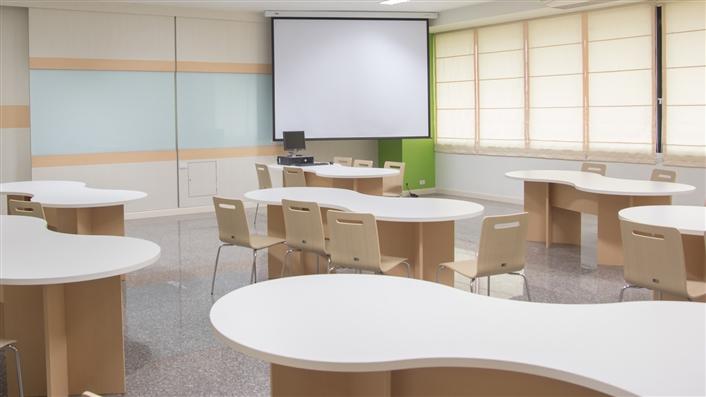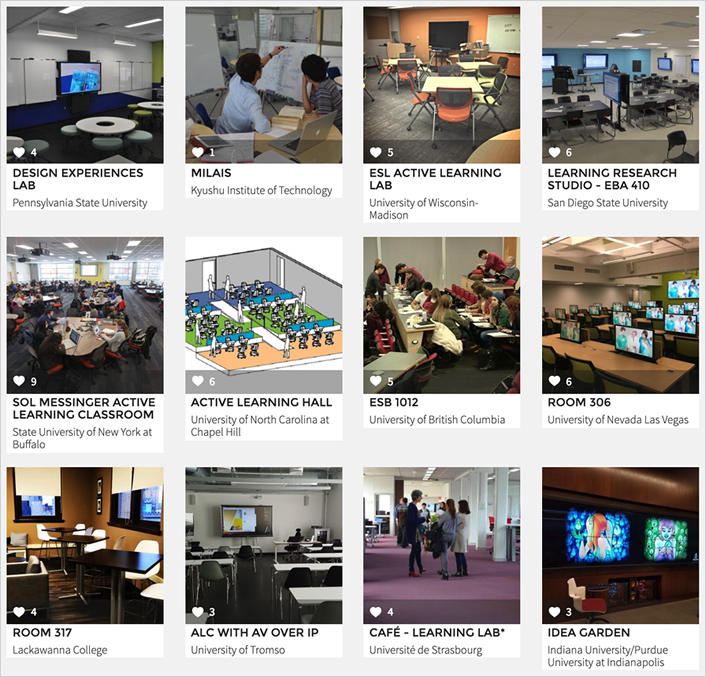FLEXspace—the Flexible Learning Environments eXchange—offers researchers and practitioners a unique opportunity to connect, collaborate, and create a shared body of knowledge about learning spaces in one central location.

In the age of new technologies, furniture, teaching strategies, and services, a vexing research question rests at the intersection of space, technology, and pedagogy. According to the 2019 Horizon Report Preview, one key trend in higher education is the growing focus on the redesign of physical learning environments. A growing body of evidence makes clear the benefits of active learning. In fact, active learning classrooms rank as the second highest priority in the EDUCAUSE Top 10 Strategic Technologies and Trends for 2019. Certainly, then, a top priority for many academic institutions is to reimagine physical spaces to support evolving user needs and maximize the impact on the institution and its communities. Researchers, practitioners, and planners seek examples, empirical research, instruments, and designs to help address their burning questions:
- How might furniture, color, lighting, or interactive displays facilitate student engagement?
- What technologies or design elements potentially have a positive impact on the student experience and learning outcomes?
- How do we "future proof" our spaces to minimize the impact of later technologies?
- What can we learn from empirical research, peer exemplars, trends, and "tales from the trenches"?
- How can we collect data on our own campus to demonstrate evidence of impact and perhaps justify expenditures on new and innovative spaces?
Enter FLEXspace.org
FLEXspace—the Flexible Learning Environments eXchange—is a searchable digital database of learning space designs, exemplars, and toolkits freely available to education communities. It has been gaining attention as a promising research platform from various groups including the EDUCAUSE Learning Space Design Community Group, SCHOMS, SCUP, CCUMC, UBTech [https://ubtechconference.com/], AVIXA, the Learning Space Collaboratory, ISTE Learning Spaces Network, the Co-Action Learning Lab, The Center for Inclusive Design and Environmental Access (IDeA) and more! It functions as a hub to support and connect a highly engaged community of researchers, experts, practitioners, faculty, and industry partners within higher education, K–12, libraries, and museums committed to improving learning space design and implementation to meet a variety of pedagogical needs (see figure 1).

Launched through a collaboration between large university systems in 2012, FLEXspace includes hundreds of detailed examples of formal and informal learning environments, ranging from multimedia studios, makerspaces, computer labs, and huddle spaces to large exhibit spaces, simulation labs, and renovated lecture halls. FLEXspace users can easily add spaces to the collection to build their own digital case study with images, videos, stories of the design rationale, and impact on learning, plus extensive details of space attributes and affordances using a robust list of tags. The FLEXspace core team developed the initial tagging taxonomy working with over 50 academics, researchers, and industry thought leaders to describe learning spaces from the perspective of three main stakeholder groups: faculty and academic staff (pedagogy), AV and IT integrators (technology), and facilities planners/architects (space). The taxonomy continues to evolve to reflect industry trends and respond to the needs of users and the research community. FLEXspace enables learning space researchers to explore the ever-growing collection and gain insights from data about space attributes and design patterns, post-occupancy usage and implementation, efficacy and impact, and more.
While FLEXspace is the most comprehensive learning spaces repository, with examples from higher education and the K–12 pipeline, what really differentiates it is the nature of the community itself. More than 3,600 individual members affiliated with 1,200 institutions from 57 countries have used the collection to spark conversations with broad stakeholder groups on campus who might not otherwise understand each other's perspectives. In 2018, a new research community, the FLEXspace Research & Evaluation Working Group ("FREWG"), was formed to explore the capabilities of FLEXspace as a research tool and a hub to connect otherwise isolated researchers from around the world. The FREWG aims to identify and advance opportunities for research and development that will facilitate evidence-based and data-informed practice in the learning spaces arena. Of particular interest are opportunities that both leverage the capabilities of FLEXspace as an open resource-sharing repository and community and contribute to its ongoing growth and development. The FREWG team will provide the FLEXspace and broader learning space community with a "research toolkit" containing guides and instruments to assist them in carrying out replicable and repeatable research and evaluation studies. This team will also help identify FLEXspace portal features and functionality to enable useful analyses. The FREWG is organizing smaller working groups in specialty areas such as learning space design patterns and analytics, virtual and hybrid-flexible (HyFlex) spaces, and inclusive design. This is a timely development, with applied research and the scholarship of teaching and learning (SoTL) currency increasing within a range of academic circles. With FLEXspace at the center of the ecosystem, "lessons learned" from the field and empirical research can be brought to the forefront, building on the work of others to develop a shared body of knowledge in one central location, readily searchable and accessible to researchers.
The FLEXspace team is collaborating with the EDUCAUSE Learning Spaces Rating System (LSRS) team to encourage integration of these two powerful tools as part of an integrated planning process. When learning space examples are added to FLEXspace, the contributor has the option to enter LSRS subscores as well as upload the entire completed LSRS scoresheet and other pertinent documentation. Researchers may use the LSRS ratings, coupled with the space and campus attributes and other information found in FLEXspace, to compare or analyze differences between spaces of similar types, gain insight into how campuses identify high- and low-performing spaces, check for consistency in planning across campuses, and find patterns in how they prioritize projects to refresh, renovate, and construct new learning spaces.
FLEXspace 2.0 Is Supercharged
With version 2.0, FLEXspace unleashes its "super power" as a connector and is fast becoming the one-stop learning space hub for research, planning tools and guidance, design examples, and implementation support. FLEXspace connects various stakeholder groups and people from different disciplines. It connects individuals and campuses to the broader community of practice. It connects theory to practice. And for individuals who are seeking empirical studies and evidence of impact or who want to conduct their own learning space studies, FLEXspace can be especially useful to connect with others doing similar work and find tools, advice, and guidance on how to collect and analyze data.
Thanks to generous input from members, researchers, and sponsor/partners, FLEXspace continues to evolve to meet user needs, and the new platform introduces features that will be especially useful to researchers.
- The Toolkit allows sharing of all kinds of learning space resources including research findings, reports, methods and instruments for research and postoccupancy assessment, and proof of concept. It is also where experts can share technical advice and specs to help guide effective planning, design assessment, and implementation support.
- Community Forum and Member Directory helps researchers, faculty, and other members connect and share resources. Do you have a question about designing a survey or observation protocol for an active learning classroom? Post it in the FLEXspace community forum or look up a researcher or expert in the member directory.
- Curated Galleries, managed by guest editors, experts, and researchers, will feature collections of select spaces (such as a gallery to showcase spaces from the Big Ten Alliance Student Design Challenge), and "recommended" toolkit resources to help bridge research and practice. There might be space galleries showcasing STEM labs, design award winners, spaces that also have published evidence of efficacy, and toolkit galleries with suggested instruments for conducting postoccupancy evaluations in active learning classrooms (e.g., focus group and survey instruments shared by UNC Chapel Hill), planning guides (e.g., the LSRS handbook or the UK Higher Education Learning Spaces Toolkit), or the latest empirical studies and industry reports.
- Idea Boards allow researchers and other members to create a shared "pin board" to collectively bookmark and discuss examples and resources found in FLEXspace.
- Institution Pages will allow campuses to assemble innovative institutional "points of pride," sharing research and assessment findings and lessons learned with colleagues at a global scale. Some campuses are planning to leverage the new portal to create a classroom directory to document all spaces, which could help support faculty using the spaces and help prioritize improvement projects. Being able to examine showcase spaces as well as "typical" spaces at a given point in time also provides researchers with useful insights.
The FLEXspace team invites you to connect as an active member of this growing community. Have you worked on a learning space project or study and have a story to share? Do you have research or assessment instruments, methodologies, data, or evidence of impact? If so, the FLEXspace community is very interested in your work. Please join at FLEXspace.org, login, and contribute your examples and resources today!
Rebecca Frazee is Manager of the FLEXspace initiative and is a faculty member in the Learning Design and Technology program at San Diego State University in the School of Journalism and Media Studies.
Lisa Stephens is Assistant Dean of the University of Buffalo School of Engineering and Applied Sciences and Senior Strategist of SUNY System Academic Innovation.
© 2019 Rebecca Frazee and Lisa Stephens. The text of this work is licensed under a Creative Commons BY-NC-SA 4.0 International License.
